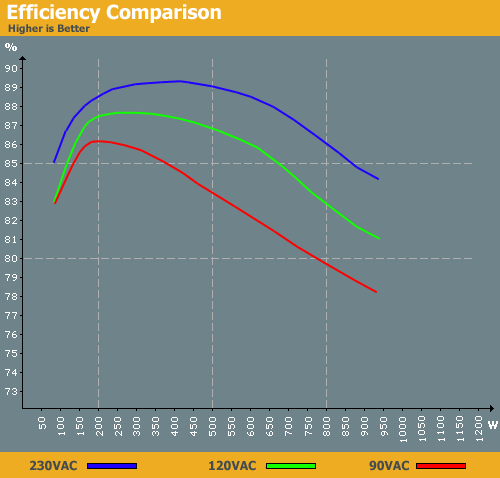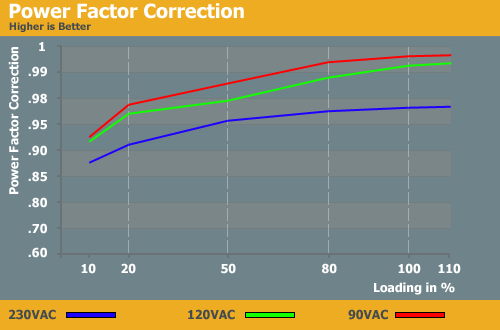Seasonic M12D 850W: DC-to-DC Perfection?
by Christoph Katzer on November 26, 2008 12:00 AM EST- Posted in
- Cases/Cooling/PSUs
Efficiency and PFC


We measured up to 89% efficiency using 230VAC, which is near the top of our efficiency charts. A few power supplies have managed 90% efficiency, but as we mentioned elsewhere a difference of 1% isn't very significant. Looking at lower input voltages, efficiency is still good but the curves aren't quite as nice, with 120VAC reaching 88% efficiency, but only for a very small range of loading. After reaching the peak efficiency, the curve on 120VAC drops pretty quickly.
The M12D doesn't support 90VAC, which is listed on a sticker next to the AC input. Normally we don't have any problems testing with 90VAC, but this particular power supply definitely doesn't work properly; voltages went up and down like a roller coaster, so we used 100VAC instead of the regular 90 for the above charts. At 100VAC, the efficiency curve looks even worse, reaching a peak value of 86% at 200W and then immediately dropping. Running a load of just 200W on an 850W power supply definitely wouldn't be the best use of your money, so if you need a lower input voltage we would look elsewhere.
Getting back to where this power supply really performs well, 230VAC delivers great results. Even with just 10% load (85W) the M12D still manages 85% efficiency, which is a fantastic result. In Europe, you can run everything from 80W up to nearly 900W and still stay above 85% efficiency. 120VAC is decent as well, staying above 83% efficiency from 80W up to 800W.

We have seen much better PFC results in other power supplies; particularly under 230VAC, this unit doesn't perform that well. It reaches a maximum of .98 -- still good, but not what most people would expect from a high-end unit. PFC with other input voltages is also lower than what we normally see.










45 Comments
View All Comments
CEO Ballmer - Saturday, November 29, 2008 - link
I have one, works nicely!http://fakesteveballmer.blogspot.com">http://fakesteveballmer.blogspot.com
InterClaw - Friday, November 28, 2008 - link
How much power does the M12D consume while in standby mode (switch on) running on 230Vac?Christoph Katzer - Saturday, November 29, 2008 - link
I will have a small update on that because I did some further testing. The M12D has an incredible high sb-efficiency with up to 76% which is really good compared to 40-ish% of many others.daar - Wednesday, November 26, 2008 - link
Can someone explain the significance for the DC-to-DC configuration over what they or other PSU manufacturers normally do? I mean other than the odd efficiency curves, it doesn't really provide anything unique when compared to say, the Enermax.PrinceGaz - Wednesday, November 26, 2008 - link
I'm guessing here and haven't checked my "facts", but I'm guessing the DC-DC conversion helps because it allows the PSU manufacturer to concentrate most of their effort on providing a clean and efficient +12V rail from the AC supply, then tag the conversion circuitry onto the end of that to generate the less critical +5V and +3.3V rails.The alternative is to have seperate circuitry for generating +12V, +5V, and +3.3V all individually from the AC supply.
JarredWalton - Thursday, November 27, 2008 - link
I believe that's right - it's easier to do 12V DC to 3.3V/5V DC than it is to do 120V/230V AC to the same, so you do one good AC-to-DC conversion and then a couple simpler DC-to-DC conversions.mindless1 - Saturday, November 29, 2008 - link
It's not necessarily easier, it's just that if you first convert to 12V alone you have maximized the amount of 12V current a single transformer of a given size can produce, then let that be the primary feedback voltage to determine switching pulse width. That typically also means you can have higher ratios of 12V to 5V or 3.3V current without going out of spec. It makes more and more sense to do so when a PSU is of high wattage as it's then expected to have so much more 12V current consumption as a % of total power used.Mr Perfect - Wednesday, November 26, 2008 - link
Maybe you could put a bug in Seasonic's ear about their "little" 120mm fan? Looking at the acoustic results, you can't help but wonder what a 140mm fan could have done for that curve. A 140mm might have shifted the whole curve down two or three decibels.piroroadkill - Thursday, November 27, 2008 - link
Bear in mind half of the fan is usually covered towards the front of the PSU, I'm really not sure a 140mm fan helps at all, because that's simply more airflow that's blocked by a baffle. This baffles me (hurr)... Seems like 120mm is perfectly adequete, and more to the point, if you so wish to change the fan yourself, at least 120mm is a standard sizeMr Perfect - Thursday, November 27, 2008 - link
140s are mainly interesting because they produce any given amount of airflow at a lower RPM then 120s. So rather then run it at the same RPM as the 120, and just block more airflow, they could run it at a lower RPM while producing the same airflow. Then maybe it would top out around 28DB instead of a 31DB, or idle at 15db instead of 17. Hopefully there wouldn't be a need to change the fan then.